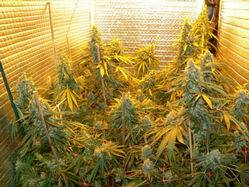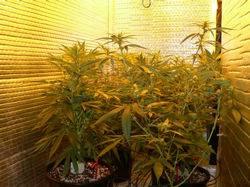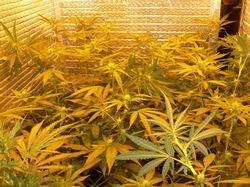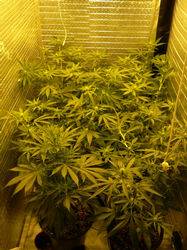Pod Racer
Member
Hello all, since I'm out of weed and waiting for my next harvest to mature I thought I would open a discussion about advanced foliar feeding techniques and FYI as I've found little but the most basic of information and anyone that knows me knows that just wont do. So, open your hearts and minds to an exploration into the world of foliar feeding. Feel free to contribute any Valuable information or discussions as knowledge is power.
My interests is primarily in exploring if there isn't a faster or more rapid way to foliar feed without causing stress or toxification of the plants. Is it possible to feed every day, every few hours, or at what interval could the leaf tissue be pressed to aid in the nutrient uptake.
As I grow primarily in a high pressure aeroponic setup I find several deficiencies that arise as the accellerated growth puts huge demands on the root systems, though full and well developed, that might be complemented by surface foliar aeration.
So, on that note here are the basics I've found:
The Basics of Foliar Feeding
For foliar fertilization to work effectively, certain guidelines must be followed:
* To be efficient and to avoid plant damage, very dilute solutions of nutrient formulations are suggested. Sometimes as little as one Tsp. to a gallon of filtered water of an active ingredient is all that is required to obtain the desired response. (1) Highly concentrated sprays, especially those bearing inorganic salt-based fertilizers, have the potential to "burn" plant foliage. This is especially true of chloride salts (e.g., potassium chloride).
* Spray-solution pH should remain in the near-neutral range (5.5-8.5). If pH adjustment is required, vinegar can be used to increase acidity, and baking soda to decrease it. (There is controversy over Baking Soda I'll explore later - I believe there is a better bicarbonate - potasium I believe).
* In addition to pH, some other qualities of spray-water should be considered:
o Cleanliness. Small, undissolved particles can quickly clog nozzles—even those well-equipped with strainers can be plugged if enough suspended matter is present.
o Chemical and disease contaminants. Some water sources are contaminated and should not be used at all for foliar feeding. If there is concern specifically about disease organisms, the water can be treated effectively with a small amount of hydrogen peroxide.
o Chlorine. Chlorination of water removes harmful bacteria, but it also can kill beneficial organisms, which may be included in some foliar sprays. Allowing water to stand in an open tank overnight generally renders chlorinated water harmless to beneficial microbial mixtures.
* Best effect is achieved when foliar sprays are finely atomized. This can be managed by increasing sprayer pressure or by using a mist blower. Some advantage can be gained on boom-type sprayers by tilting the nozzles back to a 45° angle to allow the spray to drift onto the plants.
* Spray when wind is minimal. This is especially important with finely atomized sprays because they drift readily.
* Absorption is increased when sprays also reach and coat the undersides of leaves. This is where most of the plant's stomates are located.
* Always delay foliar fertilization until air temperatures drop to 80°F or below. Absorption at higher temperatures is very poor because plant stomates are closed. Some of the most effective foliar feeding is done late in the evening or in the early dawn, when temperatures are right and wind is minimal.
* Absorption is further enhanced when weather conditions are humid and moist. The presence of heavy dew on the leaves facilitates foliar feeding.
* Addition of a surfactant to the solution decreases surface tension on the leaf and may increase absorption.
* Take note of possible chemical interactions among foliar fertilizers. Some materials are incompatible and should not be mixed together. They may create precipitates that tie up the nutrients and clog nozzles. Many product labels warn of incompatibilities. If there is no information, mix relative quantities of the materials and water in a jar and shake it. If there is no precipitate, there should be no problem.
* For convenience and cost savings, foliar fertilization can sometimes be combined with a pesticide application. However, timing conflicts and material incompatibilities can make combining sprays unwise. Be certain to read all product labels and do the jar test if uncertain.
And some more advanced ideas:
Two technologies that appear especially applicable to foliar fertilization deserve to be mentioned. The first is the use of electrostatic sprayers, which impart a charge to the spray particles and cause them to adhere more readily to plants. The second technology, known as Sonic Bloom™, uses sound to increase the leaves' absorption of nutrients.
I am currently experimenting with Folitec and Penatrator by Dutch Master as the DM One fertilizer appears the most advanced in nutrient delivery technology. I will be setting up a test to see if I can manage the same sort of 'respiration' via leaf stoma that I can achieve via aerosol infused root zones.
Anyone with experience in foliar feeding please lend your experience as I am most interested to learn more.
My interests is primarily in exploring if there isn't a faster or more rapid way to foliar feed without causing stress or toxification of the plants. Is it possible to feed every day, every few hours, or at what interval could the leaf tissue be pressed to aid in the nutrient uptake.
As I grow primarily in a high pressure aeroponic setup I find several deficiencies that arise as the accellerated growth puts huge demands on the root systems, though full and well developed, that might be complemented by surface foliar aeration.
So, on that note here are the basics I've found:
The Basics of Foliar Feeding
For foliar fertilization to work effectively, certain guidelines must be followed:
* To be efficient and to avoid plant damage, very dilute solutions of nutrient formulations are suggested. Sometimes as little as one Tsp. to a gallon of filtered water of an active ingredient is all that is required to obtain the desired response. (1) Highly concentrated sprays, especially those bearing inorganic salt-based fertilizers, have the potential to "burn" plant foliage. This is especially true of chloride salts (e.g., potassium chloride).
* Spray-solution pH should remain in the near-neutral range (5.5-8.5). If pH adjustment is required, vinegar can be used to increase acidity, and baking soda to decrease it. (There is controversy over Baking Soda I'll explore later - I believe there is a better bicarbonate - potasium I believe).
* In addition to pH, some other qualities of spray-water should be considered:
o Cleanliness. Small, undissolved particles can quickly clog nozzles—even those well-equipped with strainers can be plugged if enough suspended matter is present.
o Chemical and disease contaminants. Some water sources are contaminated and should not be used at all for foliar feeding. If there is concern specifically about disease organisms, the water can be treated effectively with a small amount of hydrogen peroxide.
o Chlorine. Chlorination of water removes harmful bacteria, but it also can kill beneficial organisms, which may be included in some foliar sprays. Allowing water to stand in an open tank overnight generally renders chlorinated water harmless to beneficial microbial mixtures.
* Best effect is achieved when foliar sprays are finely atomized. This can be managed by increasing sprayer pressure or by using a mist blower. Some advantage can be gained on boom-type sprayers by tilting the nozzles back to a 45° angle to allow the spray to drift onto the plants.
* Spray when wind is minimal. This is especially important with finely atomized sprays because they drift readily.
* Absorption is increased when sprays also reach and coat the undersides of leaves. This is where most of the plant's stomates are located.
* Always delay foliar fertilization until air temperatures drop to 80°F or below. Absorption at higher temperatures is very poor because plant stomates are closed. Some of the most effective foliar feeding is done late in the evening or in the early dawn, when temperatures are right and wind is minimal.
* Absorption is further enhanced when weather conditions are humid and moist. The presence of heavy dew on the leaves facilitates foliar feeding.
* Addition of a surfactant to the solution decreases surface tension on the leaf and may increase absorption.
* Take note of possible chemical interactions among foliar fertilizers. Some materials are incompatible and should not be mixed together. They may create precipitates that tie up the nutrients and clog nozzles. Many product labels warn of incompatibilities. If there is no information, mix relative quantities of the materials and water in a jar and shake it. If there is no precipitate, there should be no problem.
* For convenience and cost savings, foliar fertilization can sometimes be combined with a pesticide application. However, timing conflicts and material incompatibilities can make combining sprays unwise. Be certain to read all product labels and do the jar test if uncertain.
And some more advanced ideas:
Two technologies that appear especially applicable to foliar fertilization deserve to be mentioned. The first is the use of electrostatic sprayers, which impart a charge to the spray particles and cause them to adhere more readily to plants. The second technology, known as Sonic Bloom™, uses sound to increase the leaves' absorption of nutrients.
I am currently experimenting with Folitec and Penatrator by Dutch Master as the DM One fertilizer appears the most advanced in nutrient delivery technology. I will be setting up a test to see if I can manage the same sort of 'respiration' via leaf stoma that I can achieve via aerosol infused root zones.
Anyone with experience in foliar feeding please lend your experience as I am most interested to learn more.













 . This is a MJ thread.............Just joking. Damn, those are some nice buds.... density looks superb.... don't see any popcorn. The guy at the grow store swears by Dutch Master and they seem to really be into the foliar thing. His eyes are always bloodshot and look Chinese so he must be doing something right. I am going to do some research on Dutch Master. I have been using a few select Advanced Nutrient products like Overdrive with excellent results but am very interested in the foliar feeding aspect.
. This is a MJ thread.............Just joking. Damn, those are some nice buds.... density looks superb.... don't see any popcorn. The guy at the grow store swears by Dutch Master and they seem to really be into the foliar thing. His eyes are always bloodshot and look Chinese so he must be doing something right. I am going to do some research on Dutch Master. I have been using a few select Advanced Nutrient products like Overdrive with excellent results but am very interested in the foliar feeding aspect. 
 I have discovered recently that there is a chemical in Willow trees that promotes rapid rooting. You can make a tea from any willow bark or branches and use it as a rooting dip that is actually the fastest found on the planet. I just remembered this. I wonder if that same compound could be incorporated into a growth tonic. I suppose we should define what our objectives are with Foliar feeding first, he?
I have discovered recently that there is a chemical in Willow trees that promotes rapid rooting. You can make a tea from any willow bark or branches and use it as a rooting dip that is actually the fastest found on the planet. I just remembered this. I wonder if that same compound could be incorporated into a growth tonic. I suppose we should define what our objectives are with Foliar feeding first, he? 








